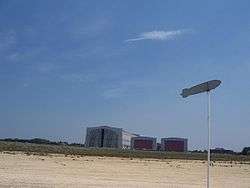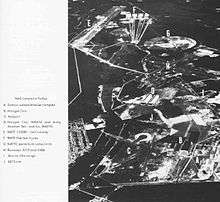Naval Air Engineering Station Lakehurst
JB MDL Lakehurst | |
|---|---|
| Part of Naval Air Systems Command (NAVAIR) | |
| Located near: Trenton, New Jersey | |
|
Front gate at Lakehurst | |
 JB MDL Lakehurst Location of JB MDL Lakehurst | |
| Coordinates | 40°02′00″N 074°21′13″W / 40.03333°N 74.35361°W |
| Site information | |
| Owner |
|
| Controlled by |
|
| Site history | |
| Built | 1916 |
| In use | 1917 – present |
| Garrison information | |
| Garrison |
 87th Air Base Wing (USAF) |
| Lakehurst Airfield Maxfield Field | |||||||||||||||||||
|---|---|---|---|---|---|---|---|---|---|---|---|---|---|---|---|---|---|---|---|
| IATA: NEL – ICAO: KNEL – FAA LID: NEL | |||||||||||||||||||
| Summary | |||||||||||||||||||
| Elevation AMSL | 100.6 ft / 31 m | ||||||||||||||||||
| Coordinates | 40°02′08″N 074°21′04″W / 40.03556°N 74.35111°W | ||||||||||||||||||
| Runways | |||||||||||||||||||
| |||||||||||||||||||




Naval Air Engineering Station Lakehurst, the former name of the Lakehurst part of Joint Base McGuire-Dix-Lakehurst, is the naval component of a United States Air Force-managed joint base located approximately 25 miles (40 km) east-southeast of Trenton in Manchester Township in Ocean County, New Jersey, United States. The unit takes its name from adjacent Lakehurst Borough. It is the Northeast's largest naval aviation center. Lakehurst is under the jurisdiction of the Air Mobility Command (AMC). It was consolidated with two adjoining Army and Air Forces facilities to become part of Joint Base McGuire-Dix-Lakehurst (JB MDL) on 1 October 2009.
Overview
Also known as Maxfield Field, the host unit at Lakehurst is the United States Air Force 87th Air Base Wing (87 ABW). The 87 ABW provides installation management to all of JB MDL.[2] The airport has an International Air Transport Association airport code, NEL.[3]
Its history begins as a munitions-testing site for the Imperial Russian Army in 1916.[4] It was then acquired by the United States Army as Camp Kendrick during World War I. The United States Navy purchased the property in 1921 for use as an airship station and renamed it Naval Air Station Lakehurst.[5]
The United States Navy's lighter-than-air program was conducted at Lakehurst through the 1930s. It was the site of the 1937 LZ 129 Hindenburg airship disaster. During World War II, anti-submarine patrol blimps were operated from Lakehurst. Since the 1950s, aviation boatswain's mates have been trained at Lakehurst to operate catapults and arresting systems on aircraft carriers. Lakehurst conducts the unique mission of supporting and developing the Aircraft Launch and Recovery Equipment and Support Equipment for naval aviation. The Electromagnetic Aircraft Launch System and the Advanced Arresting Gear system that will replace the existing steam catapults and the Mk-7 arresting gear are being developed and tested at Lakehurst at full-scale shipboard representative test facilities here.[5]
Lakehurst organizations
- NAVAIR at JB MDL specializes in Aircraft Launch and Recovery Equipment (ALRE) and Support Equipment (SE). The Aircraft Platform Interface (API) aims to ensure that fixed and vertical wing aircraft operate safely and effectively from aircraft carriers, air capable ships and expeditionary airfields worldwide.[5]
- Naval Air Warfare Center Aircraft Division[5]
- Center for Naval Educational Training, CNATT[5]
- Naval Mobile Construction Battalion 21 (Navy Reserve)[5]
- Army 1st Brigade Mid-Atlantic Recruiting Battalion (United States Army Recruiting Command)[5]
- Exercise EAGLE FLAG (USAF Expeditionary Center)[5][6]
- New Jersey Army National Guard Aviation Unit[5]
- there are other tenant organisations from Ocean County, the state of New Jersey, United States Air Force, New Jersey Air National Guard, United States Public Health Service and the United States Department of Justice.
History
Previously known as Naval Air Station Lakehurst, the installation is most famous as the site of the Hindenburg disaster on 6 May 1937. Despite the notoriety and well-documented nature of this incident, today there is a simple memorial that denotes the location of the crash at then-NAS Lakehurst in the field behind the large airship hangars on base. A ground marker, painted black, and rimmed by a bright yellow painted chain, locates where the gondola of the German zeppelin Hindenburg hit the ground.
Prior to this event, NAS Lakehurst was the center of airship development in the United States and housed three of the U.S. Navy's four rigid airships, (ZR-1) Shenandoah, (ZR-3) Los Angeles, and (ZRS-4) Akron. A number of the airship hangars built to berth these ships still survive. Hangar One, in which the Shenandoah was built, held the record for the largest "single room" in the world. According to an article in the January, 1925 issue of National Geographic Magazine, the airship hangar "could house three Woolworth Buildings lying side by side."
Maxfield Field was named 6 January 1944 in honor of Commander Louis H. Maxfield, Naval Aviator No. 17, who lost his life in the R-38/USN ZR-2 airship crash, 24 August 1921 at Hull, England.[7]
The base housed many Navy non-rigid airships, otherwise knowns as "blimps," in several squadrons before, during, and after World War II. This included the U.S. Navy's ZPG-3W (EZ-1C), which was deactivated in September 1962.[8] In 2006, after a 44-year hiatus, the U.S. Navy resumed airship operations at Lakehurst with the MZ-3A.
The former NAS Lakehurst also hosted the U.S. Navy's first helicopter squadrons, HU-1 (later HC-1) and HU-2 (later HC-2); the "A" and "C" enlisted training schools for the Aerographer's Mate (AG), Aviation Boatswain Mate (AB, ABE, ABF, ABH), and Parachute Rigger / Aircrew Survival Equipmentman (PR) ratings until their transfer to other Naval Air Technical Training Centers; and an Overhaul & Repair (O&R) facility for fixed-wing aircraft, the forerunner of the former Naval Air Rework Facilities and Naval Aviation Depots (NADEPs) now known as Fleet Readiness Centers (FRCs).
Today the base is used for various Naval Aviation development programs. NAES Lakehurst's main airfield has two 5,000 foot runways under its own control tower, while a separate 13,000 foot test runway equipped with a separate control tower and pavement-mounted catapults and arresting gear for testing aircraft carrier suitability of new naval aircraft and new flight deck systems is located approximately a mile to the northwest. In the 1950s, rail guided jet donkeys pushing dead loads at 200 knots tested carrier arresting gear cables and tailhooks.[9][10]
The Lakehurst portion of JB MDL includes activities of the Naval Air Systems Command (NAVAIRSYSCOM) and is part of the Joint Base McGuire-Dix-Lakehurst Complex.
Mission
The Lakehurst portion of JB MDL is the world's only provider of full spectrum support for aircraft launch, recovery and support equipment systems for U.S. and allied Naval Aviation Forces at sea and Marine Corps Expeditionary Aviation Forces ashore. NAVAIR provides these services 24 hours a day, 7 days a week, both from the homebase in New Jersey as well as aboard US Navy deployed ships and Marine Expeditionary Forces. From system development, prototyping and manufacturing, testing, training, and in-service engineering, the base provides the US Navy and Marine Corps aviation forces with "one-stop shopping" for all their Aircraft Platform Interface (API) needs.
Chronology
- 2017-1921 Acquired by the United States Army as an ammunition proving ground. Named Camp Kendrick.
- 1921 Commissioned as a Naval Air Station (NAS) Lakehurst. Captain Frank Taylor Evans, USN, is the first Commanding Officer.
- 1921-1961 Hosted the country's (and, perhaps, the world's) Lighter Than Air (LTA) Center.
- 1937 The German airship LZ 129 Hindenburg catches fire while approaching for a landing.
- 1958 The Naval Air Test Facility (NATF) was established.
- 1961 The Navy's LTA program was terminated, with final disestablishment no later than 1962.
- 1962 The Navy's LTA program is disestablished in November 1962.
- 1973 The Naval Air Engineering Center (NAEC) was relocated from Philadelphia as directed by a Shore Establishment Realignment.
- 1977 NAS and NATF were disestablished and merged into NAEC.
- 1986 Piasecki PA-97 Helistat crashes.
- 1992 The Naval Air Warfare Center (NAWC) was established. NAEC becomes the Naval Air Warfare Center Aircraft Division Lakehurst (NAWCADLKE).
- 1994 NAWCADLKE becomes the Naval Air Engineering Station (NAES) for shore station management and the Aircraft Platform Interface (API) Group for technical mission support.
- 1994 NAWCADLKE and the rest of the AIRCRAFT DIVISION reorganize into a Naval Air Systems Command (NAVAIR) Competency Aligned Organization (CAO).
- 1997 The Aircraft Division and Weapons Division are integrated into the Naval Aviation Systems Team's Competency Aligned Organization.
- February 2004 The installation commanders from Naval Air Engineering Station Lakehurst, the Army's Fort Dix, and McGuire Air Force Base formed a partnership to generate solutions for common problems between the three contiguous bases and their tenant commands.
- 2005 The United States Department of Defense announced that Naval Air Engineering Station Lakehurst would be affected by a Base Realignment and Closure (BRAC) action, merging it with two neighboring military bases, McGuire Air Force Base and Fort Dix, establishing Joint Base McGuire-Dix-Lakehurst, New Jersey. This was the first base of its kind in the United States. The unique contiguous arrangement of the three bases provides resident organizations with over 42,000 acres (170 km2) of unique capabilities to meet their mission needs, while surrounded by 58,000 acres (230 km2) of state and federally managed land to protect against encroachment.[11]
- 2010 Naval Air Engineering Station Lakehurst (NAES Lakehurst) is disestablished on 13 Apr 2010. The same day, Naval Support Activity Lakehurst (NSA Lakehurst) is established as a tenant activity at JB MDL, representing USN/USMC equities for Department of the Navy-specific asset and resources at JB MDL, predominantly those under the cognizance of the Naval Air Systems Command (NAVAIR). NSA Lakehurst reports to the Commander, Naval Region Mid-Atlantic (CNRMA).[12]
See also
References
- ↑ FAA Airport Master Record for NEL (Form 5010 PDF). Federal Aviation Administration. Effective 22 August 2013.
- ↑ Mission Partners webpage. Joint Base McGuire-Dix-Lakehurst (JB MDL) official website. Retrieved 2010-06-18.
- ↑ IATA airport code, NEL
- ↑ http://www.jointbasemdl.af.mil/units/lakehurst/
- 1 2 3 4 5 6 7 8 9 Joint Base McGuire-Dix-Lakehurst Lakehurst. Newpreview.afnews.af.mil. Retrieved 5 May 2012.
- ↑ http://www.expeditionarycenter.af.mil/library/factsheets/factsheet.asp?id=12286
- ↑ http://www.history.navy.mil/download/history/app11.pdf
- ↑ - "After 44 Years, Lakehurst Back in Lighter-Than-Air Flight Research," More, Kirt. Asbury Park Press, 9 May 2006.
- ↑ "Twin Jet Monorail Test Airplane Arresting Gear." Popular Science, June 1955, p. 97.
- ↑ Dempewolff, Richard F. (June 1958). Jet "Donkeys" for the Jets. Popular Mechanics. pp. 72–75. Retrieved 25 October 2012.
- ↑ http://www.lakehurst.navy.mil/nlweb/
- ↑ Naval Aviation News, Fall 2011, p. 36; published for the Chief of Naval Operations by the Naval Air Systems Command, Patuxent River, MD (USPS 323-010; ISSN 0028-1417)
External links
| Wikimedia Commons has media related to Naval Air Engineering Station Lakehurst. |
- Joint Base McGuire-Dix-Lakehurst (JB MDL) official website
- NAVAIR at Joint Base McGuire-Dix-Lakehurst official website
- NAES Lakehurst (official web site)
- Naval Air Warfare Center, Lakehurst (from GlobalSecurity.org)
- Navy Lakehurst Historical Society
- Aviation: From Sand Dunes to Sonic Booms, a National Park Service Discover Our Shared Heritage Travel Itinerary
- NAVAIR Lakehurst: One-Stop Shop for the Fleet - Naval Avtaion News (March–April 2003)
- FAA Airport Master Record for NEL (Form 5010 PDF)
- Resources for this U.S. military airport:
- FAA airport information for NEL
- AirNav airport information for KNEL
- ASN accident history for NEL
- NOAA/NWS latest weather observations
- SkyVector aeronautical chart for KNEL
- FAA Airport Diagram (PDF), effective December 8, 2016
